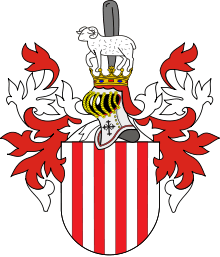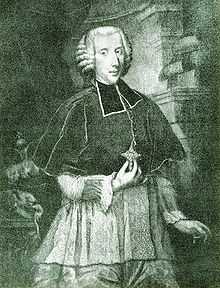House of Schaffgotsch

The Schaffgotsch family is one of the oldest noble Silesian families extant, dating back to the thirteenth century. They were first mentioned in the St. Gallen book of documents in 804 and 809, when they were domiciled in the Margraviate of Meissen, Franconia, and the Tyrol. Around 1240, the first Schaffgotsch appears in a Silesian document as Sibotho ""de nobili Familia Ovium" ("ovium" is the Latin word for "sheep", the translation of the German word Schaf(f)). According to tradition, Sibotho came in the entourage of Hedwig of Andechs and Henry I the Bearded.
One of Sibotho's successors, the knight Gotsche II Schoff (who died in 1420), bought extensive possessions in the foreland of the Riesengebirge Giant Mountains and Iser Jizera Mountains at the end of the fourteenth century: the Kynast and Greiffenstein dominions. In 1403, Gotsche II donated the church at Warmbrunn to the Cistercian provost. His family cherished the memory of Gotsche II Schoff, the originator of their wealth, by adopting the sobriquet "Gotsch". Later, both names were connected as Schaffgotsch.
Gotsche II's son Hans (who died in 1469) was the first of the family to be chancellor, court judge, and governor (German: Landeshauptmann) of the principality of Schweidnitz-Jauer (Świdnica-Jawor). With his sons Anton, Kaspar, and Ulrich, the Schaffgotsch family split into three branches.
Anton (who died in 1508) established the Bohemian branch, whose Seifersdorf and Kreppelhof-Reußendorf-Ullersdorf lines died out in the seventeenth century. This branch became Bohemian barons in 1674 and counts in 1681. The most notable members of the branch were Christoph Wilhelm (1687–1768), who was Landeshauptmann (governor) of Silesia; Johann Ernst Anton (1685–1768); senior burgrave of Prague; Johann Prokop (1748–1813), bishop of Budweis (now České Budějovice); and Anton Ernst (1804–70), bishop of Brünn (now Brno). The branch, which until 1945 resided chiefly in eastern Bohemia, died out in 1993.

The branch established by Hans's son Ulrich (1453–1543) ceased to exist in 1661; Christoph (1552–1601), grandson of Kaspar (1476–1534), had already succeeded to Ulrich's domain of Greiffenstein as early as 1578. Christoph, a Protestant, was the first ancestor of the Silesian branch of the family, which in 1766 split into the lines of Kynast-Warmbrunn and Wildschütz; Wildschütz, which resided in Austrian Silesia, died out in the first half of the twentieth century.
Christoph's son, Hans Ulrich (1595–1635), a Protestant like his father, was the only Schaffgotsch who married into a dynastic house: his wife, Barbara Agnes was a princess of Liegnitz Brieg (a descendant of the House of Ascania through her mother, Princess Anna Marie of Anhalt-Zerbst, who was the daughter of Joachim Ernst, Duke of Anhalt; through her father, Barbara Agnes descended from dukes of Silesia and from Władysław II the Exile[1]) Hans Ulrich received all rights of a Silesian sovereign and was awarded the title Semperfrei by the Holy Roman emperor. As an imperial general, he served under Wallenstein but signed the first Pilsen Revers, which the emperor considered a betrayal. Hans Ulrich was beheaded and the family were deprived of all their possessions; his son Christoph Leopold (1632–1703) converted to Roman Catholicism and recovered all estates except Trachtenberg. In 1654, Christoph Leopold became a count and was made imperial legate in Poland. In 1683, he accompanied John III Sobieski at the Battle of Vienna as the ambassador of the emperor. He was court tutor and court judge in Schweidnitz and Jauer, and chamber president and upper governor (German: Oberlandeshauptmann) of Silesia. His son Johann Anton Gotthard (1665–1742), created an imperial count (German: Reichsgraf), was director of the Silesian district authority (German: Oberamt).
After the Prussian capture of Silesia, Philipp Gotthard von Schaffgotsch (1715–1795) became bishop of Breslau. In the following generation, Johann Nepomuk Gotthard (1732–1808) received the title of "Erblandhofmeister". The family gained a seat in the Prussian House of Lords. In the first half of the nineteenth century, the family again split, into an Upper Silesian (Koppitz) line and a Lower Austrian (Niederleis) one. The Upper Silesian line, which owned the biggest coal mines in the German part of Upper Silesia, became one of the largest industrial dynasties in Germany. The Lower Austrian line, with its large possessions in and around the Riesen- and Iser Gebirge (Giant and Jesera Mountains), was considered the second wealthiest family of the region before World War I. in the 1930s, the last lord of the estate, Friedrich (1883–1947), owned 27,668 hectares, the sixth largest enterprise in Prussia.
After World War II, most members of the Schaffgotsch family were expelled from their homes because they were ethnic Germans, and the Communists confiscated their properties.

References
- U. Schmilewski, Schaffgotsch, in: Neue Deutsche Biographie, Bd 22 (Rohmer-Schinkel), München 2005, p.536-538 (German)
- Das schlesische Elysium, Arne Franke, Deutsches Kulturforum östliches Europa e. V., p. 16-19 (German)
- A. Kuzio-Podrucki, Das Haus Schaffgotsch. Das wechselvolle Schicksal einer schlesischen Adelsdynastie, Tarnowskie Góry 2009, ISBN 978-83-61458-32-6 (German)
- A. Kuzio-Podrucki, Schaffgotschowie. Zmienne losy śląskiej arystokracji, Bytom 2007, ISBN 978-83-923733-1-5, (Polish)
- About Family Schaffgotsch on the website: Silesian gentry and aristocracy (English)